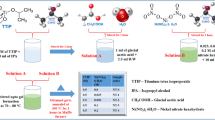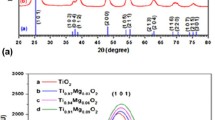Abstract
Nanocrystalline undoped and doped TiO2 particles with different concentrations of nickel and molybdenum (1-7%) was synthesized using the hydrothermal method followed by characterization using standard analytical techniques such as x-ray diffraction (XRD), scanning electron microscopy (SEM), transmission electron microscopy (TEM) and UV-Vis spectroscopy. The XRD analysis shows no change in crystal structure of TiO2 after doping with different concentration of Ni and Mo which indicates the single phase polycrystalline material. The SEM analysis shows the partial crystalline nature of undoped and doped TiO2 and TEM analysis shows the particle size were in the range of 7-11 nm for Ni and 9-13 nm for Mo-doped TiO2. The electrical and photovoltaic properties of the undoped and newly synthesized Ni- and Mo-doped TiO2 were studied. The a.c. analysis shows that the dielectric constant ε′ and dielectric loss tan δ decreases with increase in frequency and become independent at higher frequency ranges. The dielectric property decreases with increase in dopant concentration which provides the valuable information about conduction process. At low frequency, the mechanism of a.c. conductivity was found to be same as that of d.c. conduction. As the frequency increases, the magnitude of complex impedance decreases indicating the increase in a.c conductivity. It was observed that the impedance increases with the corresponding increase in the dopant concentration. Under simulated solar illumination with an optimum content of Ni and Mo involves in TiO2, the amount of dye absorption increases resulting in the gradual increase in photovoltaic current and hence improvement in the cell efficiency of dye-sensitized solar cell (DSSC) from 6.23 to 6.72% and 6.23 to 7.16% by increasing the dopant concentration of Ni and Mo from 0 to 5%, respectively, was achieved.

















Similar content being viewed by others
References
A. Zaleska, Doped-TiO2: A Review, Recent Pat. Eng., 2008, 2, p 157–164
O. Legrini, E. Oliveros, and A.M. Braun, Photochemical Processes for Water Treatment, Chem. Rev., 1993, 93, p 671–698
T. Sugimoto, X. Zhou, and A. Muramatsu, Synthesis of Uniform Anatase TiO2 Nanoparticles by Gel-Sol Method. Formation Process and Size Control, J. Colloid Interface Sci., 2003, 259, p 43–52
M.M. Haque, A. Khan, K. Umar, N.A. Mir, M. Muneer, T. Harada, and M. Matsumura, Synthesis, Characterization and Photocatalytic Activity of Visible Light Induced Ni-Doped TiO2, Energy Environ. Focus, 2013, 2, p 73–78
C. Cao, C. Hu, W. Shen, S. Wang, H. Liu, and J. Wang, Cobalt Oxide Modified Highly Ordered TiO2 Nanotube Arrays: Enhanced Visible Light Photoelectrochemical Properties, Sci. Adv. Mater., 2013, 5, p 1256–1263
H. Zhang and H. Zhu, Preparation of Fe-Doped TiO2 Nanoparticles Immobilized on Polyamide Fabric, Appl. Surf. Sci., 2012, 258, p 10034–10041
B. Liu, X. Wang, G. Cai, L. Wen, Y. Song, and X. Zhao, Low Temperature Fabrication of V-doped TiO2 Nanoparticles, Structure and Photocatalytic Studies, J. Hazard. Mater., 2009, 169, p 1112–1118
V.D. Binas, K. Sambani, T. Maggos, A. Katsanaki, and G. Kiriakidis, Synthesis and Photocatalytic Activity of Mn-doped TiO2 Nanostructured Powders Under UV and Visible Light, Appl. Catal. B, 2012, 113–114, p 79–86
G.L. Huang, M. Jani, Y.-L. Huang, and W.-C.V. Yeh, Nanowire Assemblies of Carbon Containing Mixed Phase TiO2 and Their Visible Light Photocatalytic Activities, Sci. Adv. Mater., 2013, 5, p 1444–1448
M. Muruganandham and M. Swaminathan, Solar Photocatalytic Degradation of a Reactive Azo Dye in TiO2-Suspension, Sol. Energy Mater. Sol. C, 2004, 81, p 439–457
A. Azam, A.S. Ahmad, M. Chaman, and A.H. Naqvi, Investigation of Electrical Properties of Mn doped Tin Oxide Nanoparticles Using Impedence Spectroscopy, J. Appl. Phys., 2010, 108, p 1–6
M.H. Mangrola, B.H. Parmar, A.S. Pillai, and V.S. Joshi, Structural, Optical and Electrical Properties of Titanium Dioxide Nanoparticle, Multi Discip. Edu. Glob. Quest., 2012, 1, p 138–145
P.J. Martin, Ion Based Methods for Optical Thin Film Deposition, J. Mater. Sci., 1986, 21, p 1–25
W.D. Brown and W.W. Grannemann, C-V Characteristics of Metal-Titanium Dioxide-Silicon Capacitors, Solid State Electron., 1978, 21, p 837–846
T. Fuyuki and H. Matsunmi, Electronic Properties of the Interface Between Si and TiO2 Deposited at Very Low Temperatures, Jpn. J. Appl. Phys., 1986, 25, p 1288–1291
D. Mardare and G.I. Rasu, Comparison of the Dielectric Properties for Doped and Undoped TiO2 Thin Films, J. Optoelectron. Adv. Mater., 2004, 6, p 333–336
Z. Nie, X. Zhou, Q. Zhang, G. Cao, and J. Liu, Aggregated TiO2-Based Nanotubes for Dye Sensitized Solar Cells, Sci. Adv. Mater., 2013, 5, p 1750–1755
A. Mathew, G. MohanRao, and N. Munichandraiah, Characteristics of Photo Electrodes Based on TiO2 Nanoparticles, Nanotubes and Microspheres for Dye Solar Cell, Sci. Adv. Mater., 2013, 5, p 583–591
J. Xi, N. Al Dahoudi, Q. Zhang, Y. Sun, and G. Cao, Effect of Annealing Temperature on the Performances and Electrochemical Properties of TiO2 Dye-Sensitized Solar Cells, Sci. Adv. Mater., 2012, 4, p 727–733
K.A. Salman, Z. Hasan, and K. Omar, Effect of Silicon Porosity on Solar Cell Efficiency, Int. J. Electrochem. Sci., 2012, 7, p 376–386
N.K. Singh, P. Kumar, A. Kumar, and S. Sharma, Dielectric Relaxation, Electrical Conductivity and Impedance Response of Barium Titanate and Strontium Titanate Doped Ba(Fe0.5Nb0.5)O3 Ceramics, J. Eng. Technol., 2012, 4, p 104–113
A.L. Patterson, The Scherrer Formula for X-Ray Particle Size Determination, Phys. Rev., 1939, 56, p 978–982
Y.W. Wang, L. Zhang, S. Li, and P. Jena, Polyol-Mediated Synthesis of Ultrafine TiO2 Nanocrystals and Tailored Physiochemical Properties by Ni Doping, J. Phys. Chem. C, 2009, 113, p 9210–9217
V. Stengl, S. Bakardjieva, and N. Murafa, Preparation and Photocatalytic Activity of Rare Earth Doped TiO2 Nanoparticles, Mater. Chem. Phys., 2009, 114, p 217–226
V. Stengl and S. Bakardjieva, Molybdenum-Doped Anatase and Its Extraordinary Photocatalytic Activity in the Degradation of Orange II, in the UV and Vis Regions, J. Phys. Chem. C, 2010, 114, p 19308–19317
L.G. Devi and N. Murthy, Characterization of Mo Doped TiO2 and Its Enhanced Photo Catalytic Activity Under Visible Light, Catal. Lett., 2008, 125, p 320–330
B.S. Rao, B.R. Kumar, V.R. Reddy, T.S. Rao, and G.V. Chalapathi, AC Impedence Spectroscopy Studies on Ni doped CdS Nanoparticles Prepared by Chemical CO-Precipitation Method, Chalcogenide Lett., 2012, 9, p 517–525
A.A. Saif, Z. Ajamal, Z. Sauli, and P. Poopalan, Frequency Dependent Electrical Properties of Ferroelectric Ba0.8Sr0.2 TiO2 Thin Film, Mater. Sci., 2011, 17, p 186–190
A.K.A. Gafoor, J. Thomas, M.M. Mustafa, and P.P. Pradyumnan, Effect of Sm3+ Doping on Dielectric Properties of Anatase TiO2 Nanoparticles Synthesized by a Low-Temperature Hydrothermal Method, J. Electron. Mater., 2011, 40, p 2152–2158
X. Hu, K. Huang, D. Fang, and S. Liu, Enhanced Performances of Dye-Sensitized Solar Cells Based on Graphite-TiO2 composites, Mater. Sci. Eng., B, 2011, 176, p 431–435
S.R. Kim, M.K. Parvez, and M. Chhowalla, UV-Reduction of Graphene Oxide and Its Application as an Interfacial Layer to Reduce the Back-Transport Reactions in Dye-Sensitized Solar Cells, Chem. Phys. Lett., 2009, 483, p 124–127
Acknowledgments
Financial support by the Council of Science and Technology, U.P. for providing Young Scientist Award under Young Scientist Scheme to Dr. M. M. Haque (Ref. No. CST/YSS/D-3916) and UGC New Delhi for granting Maulana Azad National Fellowship for Minority Student to Aisha Malik (No. F.40-3(M/S)/2009(SA-III/MANF), and the Centre for Excellence in Nano-Technology, Department of Applied Physics and Department of Chemistry, Aligarh Muslim University, Aligarh for providing necessary facilities are gratefully acknowledged.
Author information
Authors and Affiliations
Corresponding author
Rights and permissions
About this article
Cite this article
Malik, A., Hameed, S., Siddiqui, M.J. et al. Electrical and Optical Properties of Nickel- and Molybdenum-Doped Titanium Dioxide Nanoparticle: Improved Performance in Dye-Sensitized Solar Cells. J. of Materi Eng and Perform 23, 3184–3192 (2014). https://doi.org/10.1007/s11665-014-0954-3
Received:
Revised:
Published:
Issue Date:
DOI: https://doi.org/10.1007/s11665-014-0954-3




